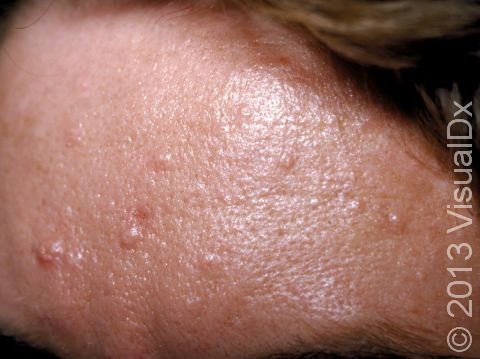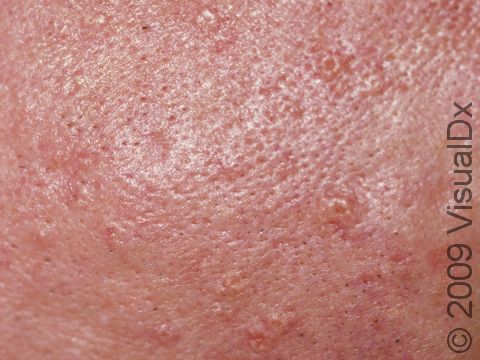Sebaceous Hyperplasia
Sebaceous hyperplasia is a common, harmless condition where sebaceous (oil) glands become enlarged and filled with an oily substance called sebum. These enlarged glands most often appear on the central face, such as the forehead. There may be just one lesion, but more often there are multiple lesions. Typically, sebaceous hyperplasia lesions are small and do not present any health concern, but in rare instances they can be numerous and become disfiguring.
Who's At Risk?
Sebaceous hyperplasia usually occurs in middle-aged and older adults. It can occur in younger individuals, though, usually in instances where the condition runs in the family.
People on long-term cyclosporin A for organ transplants are also prone to developing sebaceous hyperplasia.
Signs & Symptoms
Lesions may be single or multiple. They are seen in areas where many oil glands are found, such as the face (nose, cheeks, and forehead), chest, and upper arms.
They are small (2-9 mm), painless, yellowish or sometimes pink or tan papules (small, solid bumps), often with a central depression or dimple.
Self-Care Guidelines
Wearing cosmetics to camouflage the sebaceous hyperplasia can help those who want to minimize the appearance of the lesions.
Treatments
If there is doubt about the diagnosis, your medical professional may do a biopsy.
There are several types of treatment to remove the lesions. Note that these treatments are for cosmetic purposes and may cause scarring. Such treatments include:
- Electrodesiccation (burning).
- Cryosurgery (freezing).
- Applying topical chemicals (eg, bichloracetic acid).
- Laser treatment.
- Oral treatment such as isotretinoin for widespread, severe cases.
Visit Urgency
Sebaceous hyperplasia is harmless and there is no medical necessity to remove the lesions. However, see your medical professional if you have a new growth on the skin that is different from the other growths you have, or one that is painful or growing.
Also see your medical professional if you have sebaceous hyperplasia and:
- The lesions are cosmetically bothersome to you.
- The lesions become irritated (such as by shaving, glasses, or clothing).
- You have many lesions (over 10) or if they are growing or bleeding.
Trusted Links
References
Bolognia J, Schaffer JV, Cerroni L. Dermatology. 4th ed. Philadelphia, PA: Elsevier; 2018.
James WD, Elston D, Treat JR, Rosenbach MA. Andrew’s Diseases of the Skin. 13th ed. Philadelphia, PA: Elsevier; 2019.
Kang S, Amagai M, Bruckner AL, et al. Fitzpatrick’s Dermatology. 9th ed. New York, NY: McGraw-Hill Education; 2019.
Last modified on June 17th, 2024 at 3:09 pm

Not sure what to look for?
Try our new Rash and Skin Condition Finder


